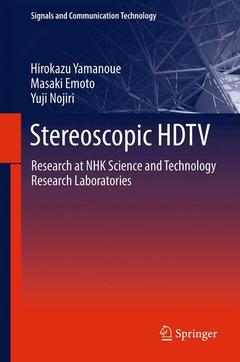Description
Stereoscopic HDTV, 2012
Research at NHK Science and Technology Research Laboratories
Signals and Communication Technology Series
Authors: Yamanoue Hirokazu, Emoto Masaki, Nojiri Yuji
Language: English
Subject for Stereoscopic HDTV:
Keywords
3D HDTV; 3DTV; Ease of viewing; Natural stereoscopic image; Visual fatigue
Approximative price 118.31 €
In Print (Delivery period: 15 days).
Add to cartPublication date: 08-2014
128 p. · 15.5x23.5 cm · Paperback
Approximative price 147.69 €
In Print (Delivery period: 15 days).
Add to cartPublication date: 07-2012
128 p. · 15.5x23.5 cm · Paperback
Description
/li>Contents
/li>Biography
/li>Comment
/li>
This book focuses on the two psychological factors of naturalness and ease of viewing of three-dimensional high-definition television (3D HDTV) images. It has been said that distortions peculiar to stereoscopic images, such as the ?puppet theater? effect or the ?cardboard? effect, spoil the sense of presence. Whereas many earlier studies have focused on geometrical calculations about these distortions, this book instead describes the relationship between the naturalness of reproduced 3D HDTV images and the nonlinearity of depthwise reproduction. The ease of viewing of each scene is regarded as one of the causal factors of visual fatigue. Many of the earlier studies have been concerned with the accurate extraction of local parallax; however, this book describes the typical spatiotemporal distribution of parallax in 3D images. The purpose of the book is to examine the correlations between the psychological factors and amount of characteristics of parallax distribution in order to understand the characteristics of easy- and difficult-to-view images and then to seek to create a new 3D HDTV system that minimizes visual fatigue for the viewer. The book is an important resource for researchers who wish to investigate and better understand various psychological effects caused by stereoscopic images.
He has received the following awards.
-Technical Development Award regarding Shooting Technologies of 3D HDTV from Motion Picture and Television Engineering Society of Japan in 1993.
-Best Paper Award from The Institute of Image Information and Television Engineers in 1994.
-Fujio Frontier Award for making stereoscopic test materials from The Institute of Image Information and Television Engineers in 1998.
(STRL is the sole research institute in Japan specializing in broadcasting technology. As a division of NHK, Japan’s national public broadcaster which broadcasts on two terrestrial television channels, three satellite television channels, and three radio channels, STRL has the role of leading Japan in broadcasting technology and enriching broadcasting culture. )
Stereoscopic program production for natural and comfortable 3D HDTV images
The relationship between psychological effects and disparity distribution in 3D HDTV images
The challenges for subjective and objective evaluation of visual fatigue in 3D viewing
These books may interest you

3D Displays 109.78 €



